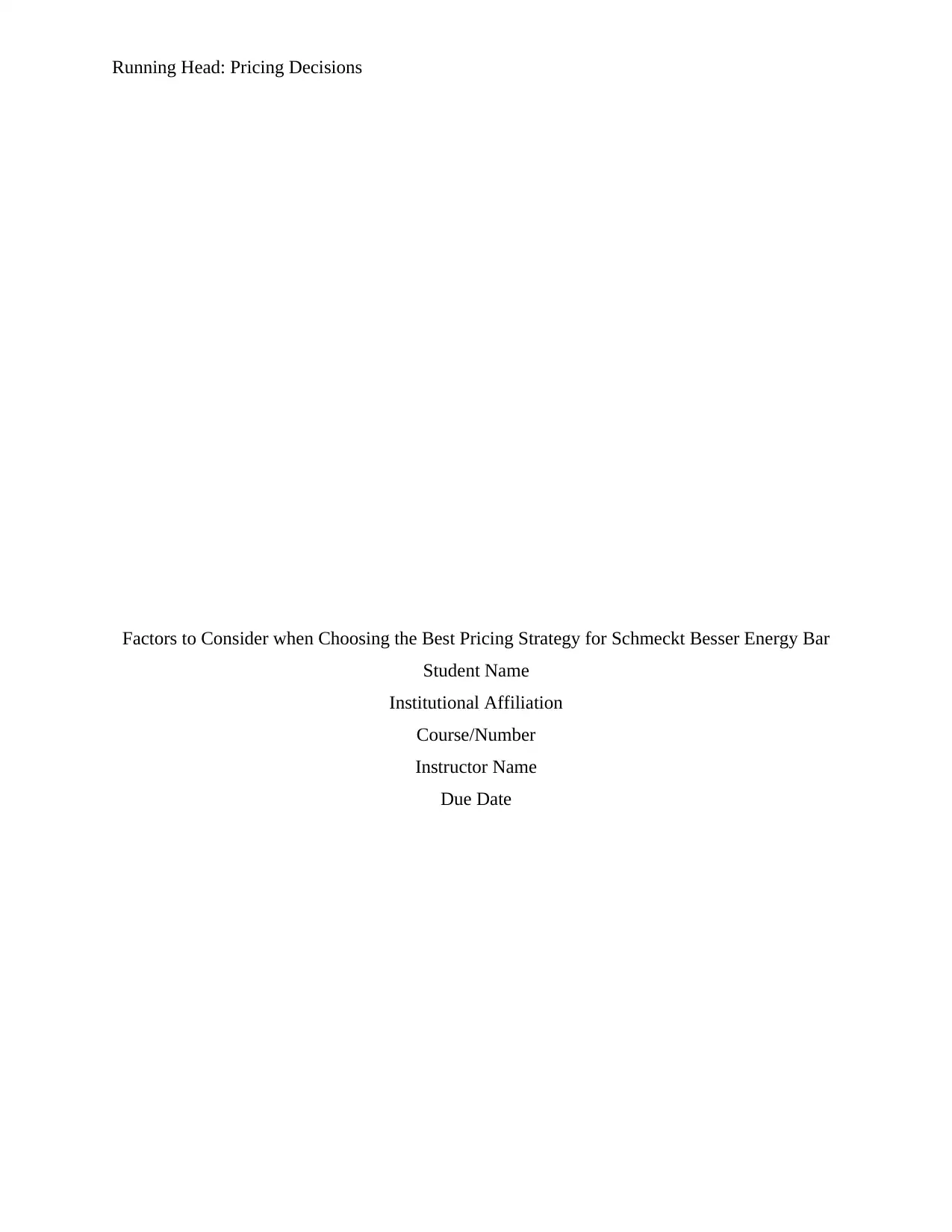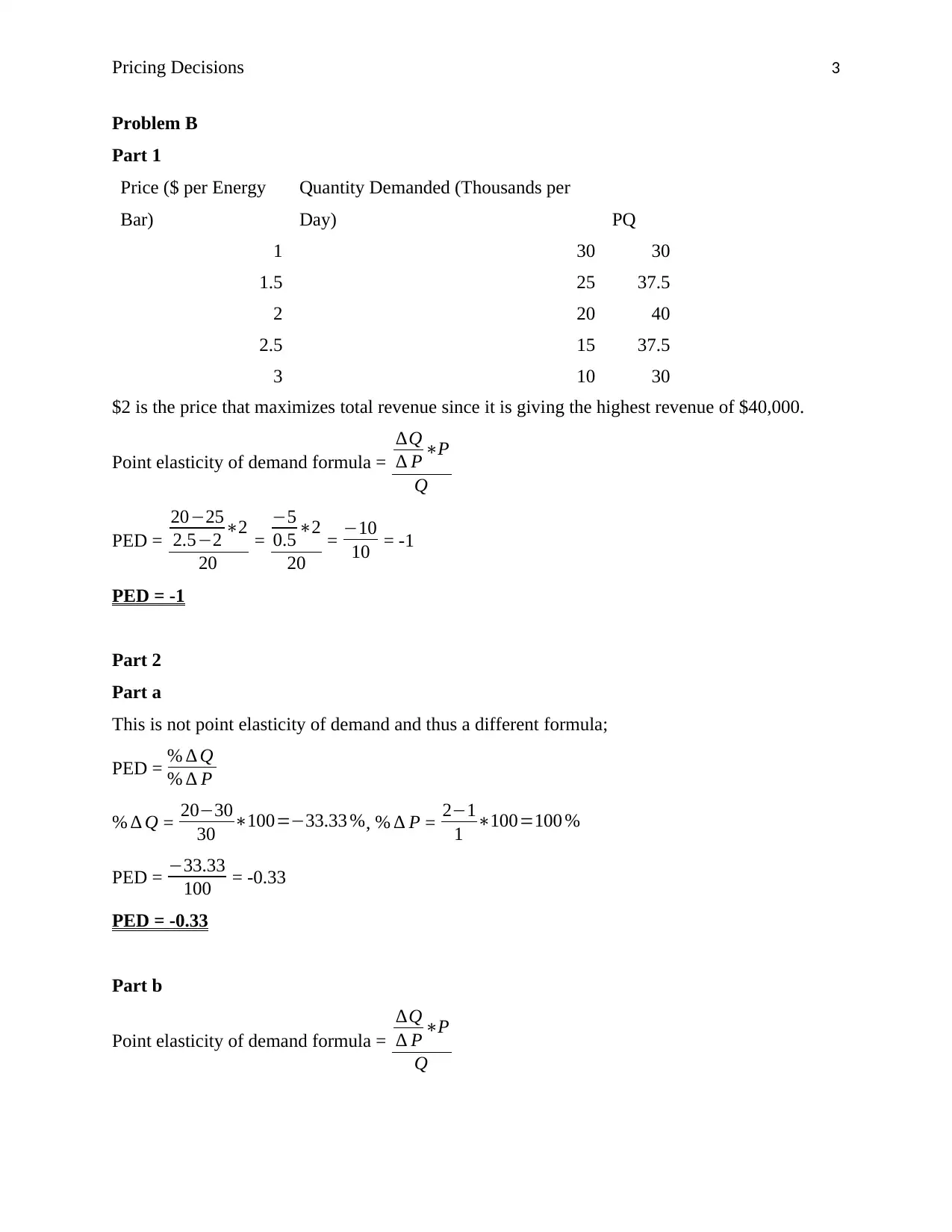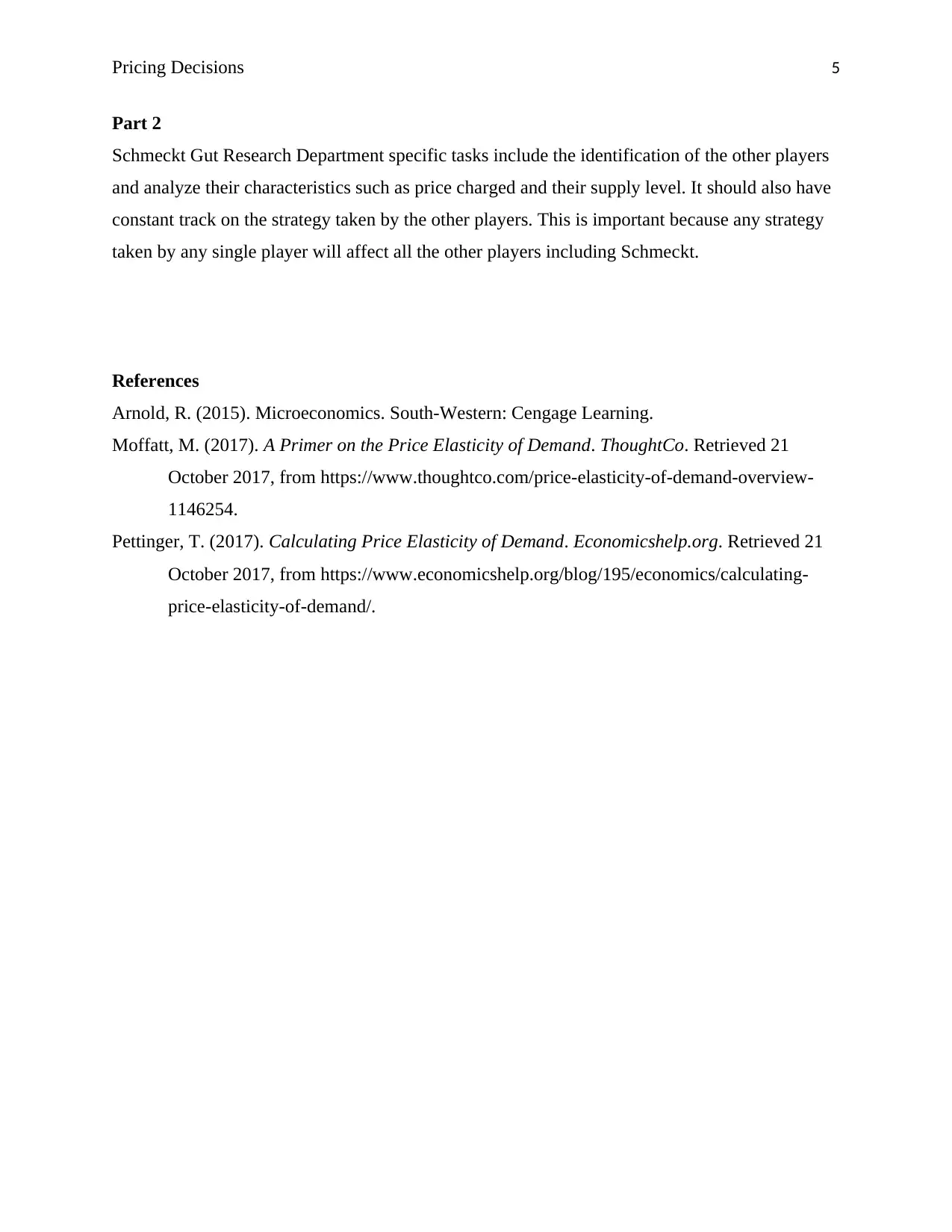Pricing Decisions: Factors to Consider for Schmeckt Besser Energy Bar
VerifiedAdded on 2020/04/29
|5
|927
|31
Homework Assignment
AI Summary
This assignment analyzes the optimal pricing strategy for the Schmeckt Besser energy bar, considering factors like price elasticity of demand, market competition, and the availability of substitutes. The student explores how to determine the nature of the product (necessity vs. luxury) and its impact on pricing. It includes calculations for point and cross-elasticity of demand, determining the relationship between Schmeckt Gut and Fly High energy bars. The paper also evaluates the market structure, concluding that the market is an oligopoly, and provides recommendations for the Schmeckt Gut Research Department to effectively introduce the energy bar, including identifying competitors, their pricing, and supply levels. The goal is to maximize revenue and ensure a smooth market introduction by understanding consumer behavior and market dynamics.

Running Head: Pricing Decisions
Factors to Consider when Choosing the Best Pricing Strategy for Schmeckt Besser Energy Bar
Student Name
Institutional Affiliation
Course/Number
Instructor Name
Due Date
Factors to Consider when Choosing the Best Pricing Strategy for Schmeckt Besser Energy Bar
Student Name
Institutional Affiliation
Course/Number
Instructor Name
Due Date
Paraphrase This Document
Need a fresh take? Get an instant paraphrase of this document with our AI Paraphraser

Pricing Decisions 2
Factors to Consider when Choosing the Best Pricing Strategy for Schmeckt Besser Energy Bar
Problem A
Part 1
Price elasticity of demand gives information to the seller about the possible reaction that
the buyers will have upon a price change (Moffatt, 2017). This is very important therefore in
deciding the price to charge for the goods produced. The topic of elasticity helps in
understanding the nature of the good depending on the magnitude of demand. A good with a
high demand even when the prices are high is considered price inelastic (Pettinger, 2017).
Similarly, a good that demand is low when prices are high is considered price elastic. Elasticity
helps the investor therefore in determining the changes that will occur to the revenues when they
vary their prices. It is crucial for the Board of Schmeckt Gut to understand that raising the price
does not always result in an increased revenue; it only happens when demand is inelastic to
price. If the demand is elastic to price, even a price rise could result in a reduced revenue. The
board should also understand that lowering prices may at sometimes increase the producer’s
revenue; this is the case where demand is price elastic; this is because more consumers will
demand the good.
Part 2
In order to ensure that the introduction of Schmeckt Besser energy bar is smooth, the
instructions the board should give the Schmeckt Gut Research Department are as follows. One is
to determine the nature of the good which will determine the magnitude of need for this product.
If the energy bar attests to be a necessity good, then the board should introduce the product at a
higher price since demand will still be significant; otherwise it should be introduced at a lower
price. The researchers should also identify the availability of close substitutes; if there are close
substitutes, the energy bar will be price elastic and thus should be introduced at a lower price;
otherwise it should be introduced at a higher price. The price should be equal or lower than for
the close substitutes if available to make it more attractive in the market.
Factors to Consider when Choosing the Best Pricing Strategy for Schmeckt Besser Energy Bar
Problem A
Part 1
Price elasticity of demand gives information to the seller about the possible reaction that
the buyers will have upon a price change (Moffatt, 2017). This is very important therefore in
deciding the price to charge for the goods produced. The topic of elasticity helps in
understanding the nature of the good depending on the magnitude of demand. A good with a
high demand even when the prices are high is considered price inelastic (Pettinger, 2017).
Similarly, a good that demand is low when prices are high is considered price elastic. Elasticity
helps the investor therefore in determining the changes that will occur to the revenues when they
vary their prices. It is crucial for the Board of Schmeckt Gut to understand that raising the price
does not always result in an increased revenue; it only happens when demand is inelastic to
price. If the demand is elastic to price, even a price rise could result in a reduced revenue. The
board should also understand that lowering prices may at sometimes increase the producer’s
revenue; this is the case where demand is price elastic; this is because more consumers will
demand the good.
Part 2
In order to ensure that the introduction of Schmeckt Besser energy bar is smooth, the
instructions the board should give the Schmeckt Gut Research Department are as follows. One is
to determine the nature of the good which will determine the magnitude of need for this product.
If the energy bar attests to be a necessity good, then the board should introduce the product at a
higher price since demand will still be significant; otherwise it should be introduced at a lower
price. The researchers should also identify the availability of close substitutes; if there are close
substitutes, the energy bar will be price elastic and thus should be introduced at a lower price;
otherwise it should be introduced at a higher price. The price should be equal or lower than for
the close substitutes if available to make it more attractive in the market.

Pricing Decisions 3
Problem B
Part 1
Price ($ per Energy
Bar)
Quantity Demanded (Thousands per
Day) PQ
1 30 30
1.5 25 37.5
2 20 40
2.5 15 37.5
3 10 30
$2 is the price that maximizes total revenue since it is giving the highest revenue of $40,000.
Point elasticity of demand formula =
∆Q
∆ P ∗P
Q
PED =
20−25
2.5−2 ∗2
20
=
−5
0.5 ∗2
20
= −10
10 = -1
PED = -1
Part 2
Part a
This is not point elasticity of demand and thus a different formula;
PED = % ∆ Q
% ∆ P
% ∆ Q = 20−30
30 ∗100=−33.33 %, % ∆ P = 2−1
1 ∗100=100 %
PED = −33.33
100 = -0.33
PED = -0.33
Part b
Point elasticity of demand formula =
∆Q
∆ P ∗P
Q
Problem B
Part 1
Price ($ per Energy
Bar)
Quantity Demanded (Thousands per
Day) PQ
1 30 30
1.5 25 37.5
2 20 40
2.5 15 37.5
3 10 30
$2 is the price that maximizes total revenue since it is giving the highest revenue of $40,000.
Point elasticity of demand formula =
∆Q
∆ P ∗P
Q
PED =
20−25
2.5−2 ∗2
20
=
−5
0.5 ∗2
20
= −10
10 = -1
PED = -1
Part 2
Part a
This is not point elasticity of demand and thus a different formula;
PED = % ∆ Q
% ∆ P
% ∆ Q = 20−30
30 ∗100=−33.33 %, % ∆ P = 2−1
1 ∗100=100 %
PED = −33.33
100 = -0.33
PED = -0.33
Part b
Point elasticity of demand formula =
∆Q
∆ P ∗P
Q
⊘ This is a preview!⊘
Do you want full access?
Subscribe today to unlock all pages.

Trusted by 1+ million students worldwide

Pricing Decisions 4
PED =
20−25
2−1.5 ∗1.5
25
=
−5
0.5 ∗1.5
25
= −7.5
12.5 = -0.6
PED = -0.6
Part 3
Cross-elasticity of demand = % change∈quantity demanded of a good
% change∈the price of another good
% change in the demand of Schmeckt Gut Energy bar = 20−10
10 ∗100=100 %, % change in the
price for Fly High’s energy bars 9−11
11 ∗100=−18 . 18 %
Cross-elasticity of demand = 100
−18.18 = -5.5
Cross-elasticity of demand = -5.5
Part 4
The relationship between the Energy bars from Schmeckt Gut and those from Fly High is for
complementary goods. This is because the movement between the quantity demanded for
Schmeckt Gut Energy bars and the price for Fly High Energy bars is on opposite directions
(Arnold, 2015). This is represented by the negative sign of the cross-elasticity of demand.
Problem C
Part 1
The Schmeckt Besser energy bar could be smoothly introduced into the market by
determining the nature of competition that exist in the market. Based on the argument that the
Schmeckt is able to lower its prices so as to influence its quantity level, this makes this market an
oligopoly. This is proved further by the influence of one price on the price of another producer.
Further, we already confirm that this is not a perfectly competitive market because if it is,
Schmeckt could not be concerned with the introduction price as it is already provided in the
market. Thus, Schmeckt should understand how the players in the oligopoly markets influence
the price and quantity level. This firm should also identify the target group and tailor its products
according to this group so as to make the goods more competitive.
PED =
20−25
2−1.5 ∗1.5
25
=
−5
0.5 ∗1.5
25
= −7.5
12.5 = -0.6
PED = -0.6
Part 3
Cross-elasticity of demand = % change∈quantity demanded of a good
% change∈the price of another good
% change in the demand of Schmeckt Gut Energy bar = 20−10
10 ∗100=100 %, % change in the
price for Fly High’s energy bars 9−11
11 ∗100=−18 . 18 %
Cross-elasticity of demand = 100
−18.18 = -5.5
Cross-elasticity of demand = -5.5
Part 4
The relationship between the Energy bars from Schmeckt Gut and those from Fly High is for
complementary goods. This is because the movement between the quantity demanded for
Schmeckt Gut Energy bars and the price for Fly High Energy bars is on opposite directions
(Arnold, 2015). This is represented by the negative sign of the cross-elasticity of demand.
Problem C
Part 1
The Schmeckt Besser energy bar could be smoothly introduced into the market by
determining the nature of competition that exist in the market. Based on the argument that the
Schmeckt is able to lower its prices so as to influence its quantity level, this makes this market an
oligopoly. This is proved further by the influence of one price on the price of another producer.
Further, we already confirm that this is not a perfectly competitive market because if it is,
Schmeckt could not be concerned with the introduction price as it is already provided in the
market. Thus, Schmeckt should understand how the players in the oligopoly markets influence
the price and quantity level. This firm should also identify the target group and tailor its products
according to this group so as to make the goods more competitive.
Paraphrase This Document
Need a fresh take? Get an instant paraphrase of this document with our AI Paraphraser

Pricing Decisions 5
Part 2
Schmeckt Gut Research Department specific tasks include the identification of the other players
and analyze their characteristics such as price charged and their supply level. It should also have
constant track on the strategy taken by the other players. This is important because any strategy
taken by any single player will affect all the other players including Schmeckt.
References
Arnold, R. (2015). Microeconomics. South-Western: Cengage Learning.
Moffatt, M. (2017). A Primer on the Price Elasticity of Demand. ThoughtCo. Retrieved 21
October 2017, from https://www.thoughtco.com/price-elasticity-of-demand-overview-
1146254.
Pettinger, T. (2017). Calculating Price Elasticity of Demand. Economicshelp.org. Retrieved 21
October 2017, from https://www.economicshelp.org/blog/195/economics/calculating-
price-elasticity-of-demand/.
Part 2
Schmeckt Gut Research Department specific tasks include the identification of the other players
and analyze their characteristics such as price charged and their supply level. It should also have
constant track on the strategy taken by the other players. This is important because any strategy
taken by any single player will affect all the other players including Schmeckt.
References
Arnold, R. (2015). Microeconomics. South-Western: Cengage Learning.
Moffatt, M. (2017). A Primer on the Price Elasticity of Demand. ThoughtCo. Retrieved 21
October 2017, from https://www.thoughtco.com/price-elasticity-of-demand-overview-
1146254.
Pettinger, T. (2017). Calculating Price Elasticity of Demand. Economicshelp.org. Retrieved 21
October 2017, from https://www.economicshelp.org/blog/195/economics/calculating-
price-elasticity-of-demand/.
1 out of 5
Related Documents
Your All-in-One AI-Powered Toolkit for Academic Success.
+13062052269
info@desklib.com
Available 24*7 on WhatsApp / Email
![[object Object]](/_next/static/media/star-bottom.7253800d.svg)
Unlock your academic potential
Copyright © 2020–2025 A2Z Services. All Rights Reserved. Developed and managed by ZUCOL.





